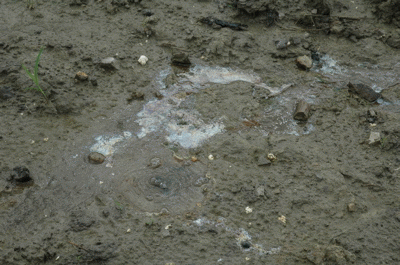Mark Twain once said about editors—“ I am not the editor of a newspaper and shall always try to do right and be good so that God will not make me one.”
The same might be said about Tim Doody, president of the eleven-member Southeast Louisiana Flood Protection Authority-East in New Orleans. He might well be asking himself the question Twain posed in terms of his appointment to the local levee authority.
Doody has held the volunteer post since July 2007. He makes it clear right off the bat that he is not an engineer, but a CPA and director of the Chaffe McCall law firm.
Doody has his hands full right now trying to seat an independent review panel to look at leaks on the 17th street drainage canal that failed catastrophically during the aftermath of hurricane Katrina, flooding much of New Orleans.
Image: New seepage near 17th Street Canal on Tuesday
In March of this year, The New Orleans Times Picayune summarized comments from an outside engineering expert from California who addressed the 17th Street Canal leaks. “Water persistently seeping out of the 17th Street Canal near the repaired levee and floodwall indicates serious flaws in the design, not only of that levee section but of much of the multibillion-dollar 100-year hurricane protection for the region,” the Times reported. The newspaper referred to comments made by University of California-Berkeley civil engineering professor Robert Bea.
The local levee authority has ownership of both the flood control and river control levees in the parishes in New Orleans. But, the USACE (Army Corps) has responsibility for the new construction on the 17th Street Canal.
“I have been in touch with the American society of Civil Engineers (ASCE) and finally compiled a list of fifteen names of truly independent engineers who have not worked for the Army Corps of Engineers (USACE),” Doody said in a phone conversation. He has to find three engineers from that list who are willing to examine what is a happening along the levee bank where water has been bubbling to the surface along the repaired breach since at least March 2008.
Doody also made it clear that he takes his post very seriously.
"I truly feel a sense of duty in serving on the board - I lost my home, alongwith my family (all have relocated) as a result the hurricane, " Doody said.
Corps engineers maintain that the seepage is not cause for alarm.
Randall Cephus, press officer for the New Orleans USACE, came out to the levee with us to take some more photos of the bubbling water, which appeared to have increased in flow since Sunday. Cephus came out on short notice.
Image: Randall Cephus PAO USACE and Sandy Rosenthal of levees.org
When asked what the USACE planned to do about the situation, Cephus said that the Corps did not want to disturb the ground around the three points of flowing water, since it would essentially “taint the investigative work” of the planned review board.
We noted that direct access to the leaks had been reinforced with a double padlock—installed since our initial visit and report two days prior. Senator Mary Landrieu (D-LA) was in New Orleans on Monday, and after Levees.org mailed her photos of the leaks and ducks swimming in pooled water on road nearby, Landrieu’s office said that the Senator would be in contact with the New Orleans Corps office to make sure they were addressing the issue.
The Corps subsequently sent an investigative team out to the site and determined that the flowing water from the three points was brackish, meaning the points have a salt-water component and were definitely coming from the drainage canal.
(Note: You can view every article as one long page if you sign up as an Advocate Member, or higher).






